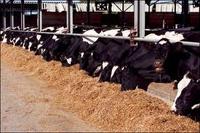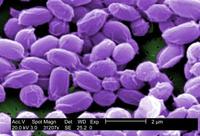-
DHS S&T launches $100,000 prize competition to support NBAF facility
DHS S&T announced the National Bio and Agro-Defense Facility (NBAF) Think and Do Challenge, a prize competition that seeks ideas to leverage NBAF resources in order to conduct research to protect the nation’s animal agricultural industry and public health. S&T says that it will award up to $100,000 to help fund the development or implementation of winning submissions through the NBAF Think and Do Challenge, under the authority of the America COMPETES Act.
-
-
Safety concerns dog new Level 4 Biolab being built in the middle of Tornado Alley
The new Department of Homeland Security’s(DHS) animal pathogen-research facility, a Level 4 Biolab being built in Manhattan, Kansas and aiming to replace the aging New York’s Plum Island lab, is situated in the middle of Tornado Alley, leading researchers and security experts to question the wisdom of the decision to build it there. Why place a lab in which research is conducted on pathogens for which no cure or treatment has yet been found – fir example, foot-and-mouth disease – not only in an area known for being routinely hit by powerful tornadoes, but also in the middle of a region where most U.S. cattle is being raised?
-
-
Groundbreaking for new Biosafety Level 4 lab in Kansas
Officials on Wednesday broke ground for the National Bio and Agro-Defense Facility (NBAF), a $1.25 billion animal research facility near the campus of Kansas State University in Manhattan, Kansas. NBAF will be the U.S. only Level 4 biosafety lab – a designation which means that the lab is secure enough to handle, and conduct research on, pathogens that do not currently have treatments or countermeasures. Critics argue that locating the lab on the campus of KSU — in the heart of cattle country and the middle of Tornado Alley – would not be a good idea. NBAF will replace the aging biolab in Plum Island, New York.
-
-
DHS S&T awards $834 million contract for construction of Manhattan, Kansas biolab
DHS Science and Technology Directorate (S&T) yesterday announced the award of a contract for the final phase of construction of the National Bio and Agro-Defense Facility (NBAF) being constructed in Manhattan, Kansas. The $834 million award by S&T’s procurement support partner, the Federal Law Enforcement Training Centers (FLETC), modifies the existing contract for McCarthy Mortensen NBAF Joint Venture, which was selected in 2009.
-
-
Escape of deadly bacteria at Louisiana bio-research facility raises concerns
Weeks after federal and state officials launched an investigation into how the burkholderia pseudomallei bacteria which causes life-threatening disease Melioidosis, escaped a laboratory at the Tulane National Primate Research Center in Louisiana, another investigation is now looking into how a veterinary clinic worker might have been exposed to the bacteria.Tulane was conducting vaccine research on the bacteria in a laboratory that requires a biosafety level 3 rating — - the second highest security level.
-
-
NBAF-focused research already underway at K-State U, ahead of level-4 biolab opening
Although the remaining funding for the National Bio and Agro-defense Facility, or NBAF, was recently finalized, work on the federal livestock research facility has continued to move forward in recent years — including Kansas State University conducting research which will help jump-start future operations at NBAF. NBAF will be DHS’s premier foreign animal disease research lab. It will research high-consequence livestock diseases that threaten animal and human health. The $1.25 billion lab will be on the northeast edge of K-State Manhattan, Kansas campus. NBAF is anticipated to begin operations in 2022 or 2023. Construction of the facility’s central utility plant is more than 90 percent complete.
-
-
Agroterrorism is a major threat to America: Experts
The economic effects of a successful attack on the U.S. food supply would be devastating, as agriculture accounts for roughly 13 percent of the country’s gross annual domestic product. An introduction of deadly pathogens into U.S. livestock, poultry, or crops would not only result in a disease outbreak, but would disrupt the global food industry and drive up food prices. Agroterrorism is not limited to the intentional introduction of harmful pathogens into U.S. farms and livestock. Terrorists can also cyberattack industrial agriculture systems responsible for operating feeding machines, maintaining milk temperatures, and processing foods.
-
-
Protecting the U.S. food supply from agroterrorism

“For the life of me, I cannot understand why the terrorists have not attacked our food supply because it is so easy to do,” said Tommy Thompson during his 2004 farewell speech when he left his post as U.S. secretary of Health and Human Services. Documents found in a 2002 U.S. military raid on an al-Qaeda warehouse showed that terrorists sought to contaminate the U.S. food supplies. The documents included detailed instructions for attacking U.S. agricultural assets. Researchers at the University of California-Davis’ Western Institute for Food Safety and Security(WIFSS) are studying vulnerabilities of the U.S. agricultural system to the threats of agroterrorism.
-
-
Leidos awarded DHS Plum Island biolab contract
DHS awarded Reston, Virginia-based Leidos a prime contract to support and supplement the Science and Technology (S&T) Agricultural Scientific Program at the Plum Island Animal Disease Center (PIADC). The single-award time and materials (T&M) contract has a one-year base period of performance, four one-year options, and a total contract value of approximately $12 million if all options are exercised. Work will be performed in Orient Point, New York.
-
-
New biodefense centers offer modernized approach, face criticism
A new facility at Texas A&M University is one of three new biodefense centers created by the U.S. Department of Health and Human Services (HHS) to revolutionize the way fatal viruses are countered in the event of an emergency. The $286-million lab features mobile clean rooms that can be detached and moved to form different production or testing systems as the need arises. Not everyone agrees that the design and capabilities of the new center would offer the best response to biothreats.
-
-
Food-related disease outbreaks can teach us about the consequence of food terrorism
Since unintentional food-related outbreaks have become so common, policy makers could use data from unintended foodborne disease outbreaks to estimate the effects of intended foodborne disease outbreaks. The impact on trade and economies is the primary motive for food terrorism, according to the World Health Organization (WHO), but beyond the financial loss, such intended foodborne disease outbreaks may even impact political stability.
-
-
FDA proposes rules to prevent terror attack on U.S. food supply
Food terrorism could have drastic economic effects. A DHS risk assessment discovered that should a pathogen like foot-and-mouth disease be introduced to Great Plains ranchers, total damages would exceed $50 billion, affecting U.S. beef exports and dramatically reducing consumer demand for beef products.In order to prevent or reduce the risk from a potential terror attack on the nation’s food supply, the FDA proposed new rules to the Food Safety Modernization Act (FSMA).
-
-
DHS awards contract for utility plant at the Kansas biolab
DHS has awarded a $40 million contract to build a utility plant at a $1.15 billion animal research lab in Kansas. The 87,000 square foot facility will replace an animal research lab on Plum Island in New York and will be used to research deadly animal diseases that affect livestock.
-
-
Researchers find anthrax can grow and reproduce in soil

Anthrax has the unexpected ability to grow and reproduce while lurking in soil — increasing the deadly bacteria’s chances to infect cattle and other mammals; researchers have found that the spores can attack a common soil and water amoeba, Acanthamoeba castellanii, turning these single-celled organisms into anthrax incubators
-
-
New U.S. biodedfense R&D network launched
On Monday, Texas A&M System dedicated a new research center which is part of a national network of centers aiming to develop strategies and products to counter bioterrorism, chemical and radiological attacks on the United States, and better strategies to deal with pandemics; the network will have facilities in Texas, Maryland, and North Carolina; the Texas dedication is the culmination of a Manhattan Project-like program for biological countermeasures, launched in 2004 by the Department of Health and Human Services; the research network aims to develop “rapid, nimble and flexible approaches” to vaccine and therapy development, and train the next generation of professionals to sustain U.S. capabilities in these areas
-
- All
- Regional
- Water
- Biometrics
- Borders/Immig
- Business
- Cybersecurity
- Detection
- Disasters
- Government
- Infrastructure
- International
- Public health
- Public Safety
- Communication interoperabillity
- Emergency services
- Emergency medical services
- Fire
- First response
- IEDs
- Law Enforcement
- Law Enforcement Technology
- Military technology
- Nonlethal weapons
- Nuclear weapons
- Personal protection equipment
- Police
- Notification /alert systems
- Situational awareness
- Weapons systems
- Sci-Tech
- Sector Reports
- Surveillance
- Transportation
Advertising & Marketing: advertise@newswirepubs.com
Editorial: editor@newswirepubs.com
General: info@newswirepubs.com
2010-2011 © News Wire Publications, LLC News Wire Publications, LLC
220 Old Country Road | Suite 200 | Mineola | New York | 11501
Permissions and Policies
Editorial: editor@newswirepubs.com
General: info@newswirepubs.com
2010-2011 © News Wire Publications, LLC News Wire Publications, LLC
220 Old Country Road | Suite 200 | Mineola | New York | 11501
Permissions and Policies
